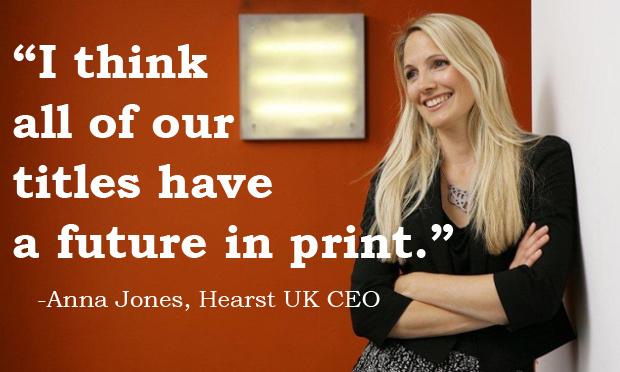[responsive] [/responsive]What’s terrifying to some is exhilarating to others, and Anna Jones falls squarely in the latter. Speaking to The Guardian’s Oscar Williams, the Hearst UK CEO waxed bullish on the future of the magazine industry.
[/responsive]What’s terrifying to some is exhilarating to others, and Anna Jones falls squarely in the latter. Speaking to The Guardian’s Oscar Williams, the Hearst UK CEO waxed bullish on the future of the magazine industry.
“It’s one of the most nerve-racking things for people working in media – or the most exciting and exhilarating if you’re me, because we just don’t know what’s going to happen.”
That excitement is evident in Jones’ platform-agnostic approach, and not knowing adds an element where customer demand and creativity are allowed to co-exist.
“I’m utterly platform-agonistic and my whole team are very focused on giving the consumer what they want,” Jones notes. “If they want it on tablet, mobile, if they want to come to an event, we’ll organise an event for them, and increasingly they do. If they want it in print they can have it in print.”
And while digital is becoming increasingly a part of the Hearst content mix, print remains a pillar in the company’s plans, without question.
“We have quite a number of titles that are selling more year-on-year. I think all of our titles have a future in print,” she notes. That insistence on print as a primary medium for magazines was behind the decision to launch a British version of Town and Country last spring.
The new title’s first two editions ran at 60,000 plus in the UK, in tandem with a sister website that includes verticals in property, society, out & about, style, dogs and horses, notes Williams.
Her big peeve at the moment? Jones takes issue with those who would lump magazines and newspapers into one category.
“I get frustrated that everybody talks about the print business in the same way and lumps magazines and newspapers together when they’re actually quite different beasts,” Jones notes.
With one sharp eye on the market and a finger on the pulse of contemporary society, Jones is in a good position to leverage print for the Hearst UK brand and use it as a platform to discuss the ideas of feminism in the younger generations. Part of their commitment to the dialogue on women’s issues is reflected in how the company is portraying women in magazines like Esquire.
“When I started working in media, FHM was selling 750k copies a month and it usually had somebody with very few clothes on the cover,” Jones says. “I think that looks old-fashioned. What we’ve found on Esquire is our better selling issues feature a very smart, suited and booted A-lister on the cover.”
Socially conscious, financially adept and editorially sound – we think the Hearst UK brand in print is definitely on the right track.
